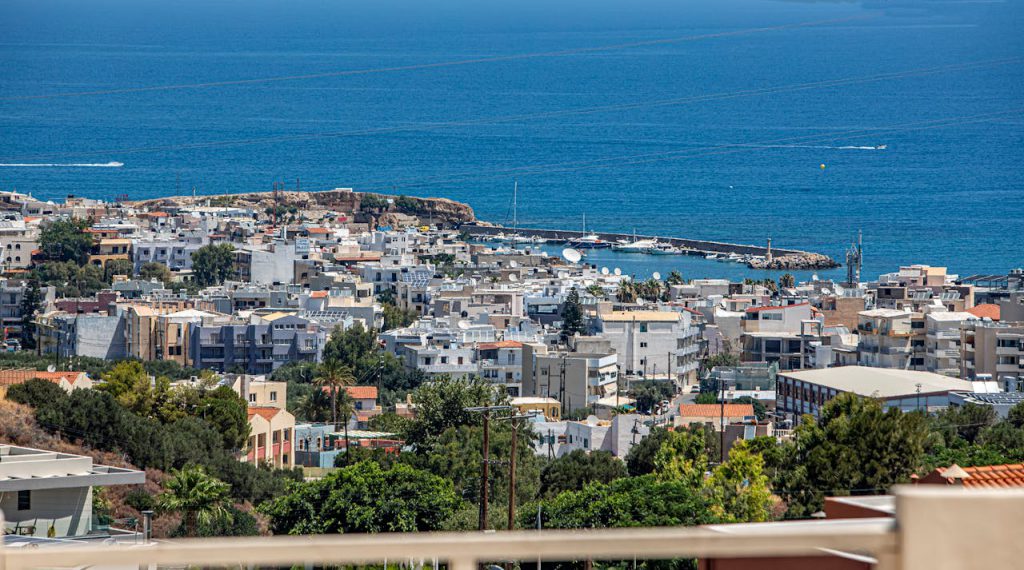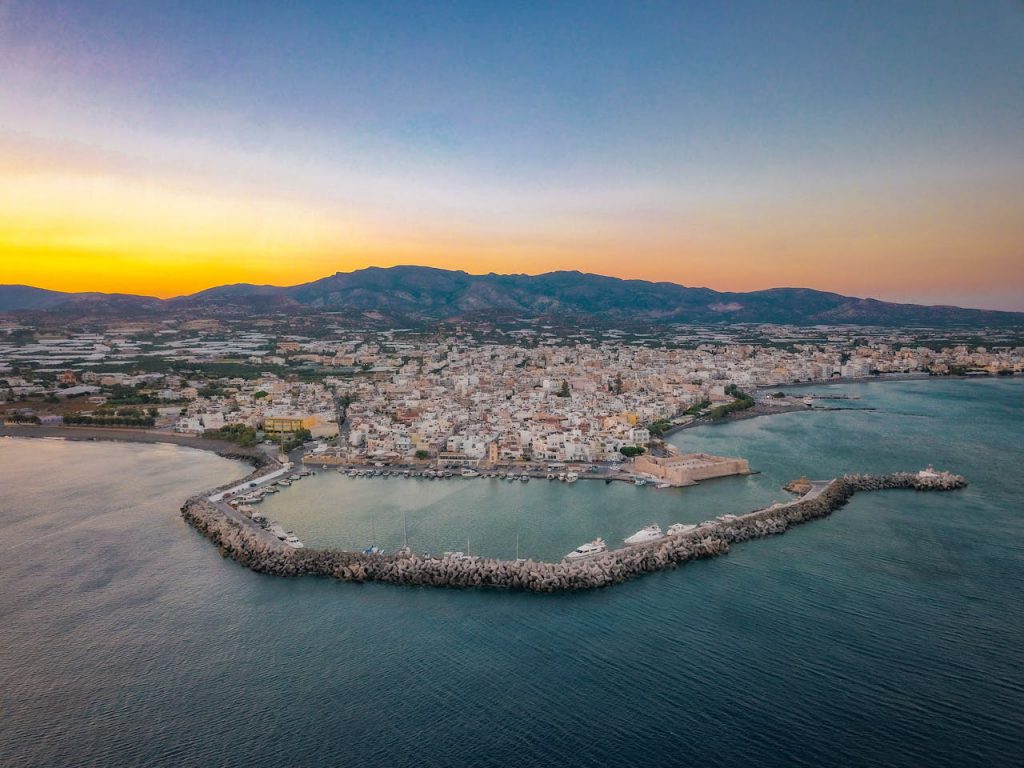
It is the largest island in Greece, a place that has been fascinating travelers for centuries. Dropped right in the middle of the Mediterranean Sea, this island paradise holds a rich history, outstanding landscapes, and a special culture that makes it stand out from its European neighbors. What exactly is the location of Crete, and what makes its position special? Let us find out with a little journey about geographical wonders on this amazing island.
Location and Geography
Draw a line from the southern tip of Greece toward the north coast of Africa. About halfway along this imaginary path lies the island of Crete, proudly standing as a bridge between Europe and Africa. More precisely, it is located in the eastern Mediterranean, about 160 kilometers south of the Greek mainland.
It is long in shape, extending from east to west for some 260 kilometers, while the width varies from 12 to 60 kilometers. This shape has gained Crete the nickname of “The Great Island” by locals and visitors alike. Its strategic position has made it a crucial crossroads of civilizations throughout history, influencing its culture, cuisine, and way of life.
The coordinates of Crete are between 34° and 35° N latitude and between 23° and 26° E longitude. This position endows the island with a Mediterranean climate, characterized by mild winters and hot, dry summers—perfect for those wishing for a sunny retreat.

Geographical Features: Mountains, Valleys, and Coastline
One could taste the raw beauty of nature throughout Crete. Dominated by the three well-defined mountain ranges crossing the island from west to east, it creates a landscape both rugged and varied; therefore, these built the history and culture on this island.
The Lefka Ori, or White Mountains, in the west, pierce the sky with jagged peaks that reach as high as Pachnes, 2,453 meters, or 8,048 feet. Their deep gorges are famous—such as that of the spectacular Samaria Gorge—the destination for many hikers from all over the world.
Central Crete is home to Mount Ida, the highest peak of the island, reaching 2,456 meters. This was the mountain considered to be the birthplace of Zeus himself in Greek mythology, king of the ancient Greek gods. Its flanks are dotted with traditional villages and ruins dating back centuries ago, an element providing an idea about Crete’s rich past.
In the east are the dramatic backdrops of the peaks of Dikti, reaching as high as 2,148 meters (7,047 feet). Within these mountains lies the Lasithi Plateau, well-tilled, fertile, and full of iconic windmills; abundance characterizes this plateau.
Within these mountain ranges, fertile valleys and plateaus nestle; in these areas, much of Crete’s produce is grown. In such areas, one encounters many olive groves, vineyards, and citrus orchards that contribute to the famous cuisine and agricultural exports of the island.
The coastline of Crete is over 1,000 kilometers long and equally impressive. The north coast faces the Aegean Sea and is generally more developed, hosting the larger cities and popular tourist resorts. Here, you will find long stretches of sandy beaches with rocky coves and charming fishing villages.
The south coast is wilder, less developed, and meets the Libyan Sea. It’s characterized by dramatic cliffs, secluded beaches, and small, traditional settlements. This coast represents an ideal place for visitors who want to experience a real off-the-beaten-path adventure.
On the other hand, the tips of the island to the east and the west have their own special character: the palm-fringed beaches and the famous Vai Beach in the east, the pink sand of Elafonisi, and the historic harbor of Chania in the west.
Part of Greece: Crete as a Greek Island and an Administrative Region
Though the location of Crete may make it seem remotely situated and somewhat insular, it belongs vitally to Greece. Not only is Crete the largest Greek island, but also one of the 13 administrative regions of Greece. That means, though Crete has quite a unique culture and traditions, it is wholly inside the Greek political and economic system.
There are four regional units: Chania, Rethymno, Heraklion, and Lasithi. Each has its own capital town, with Heraklion being the biggest city and administrative capital of the entire island. These divisions mirror, in a way, the diverse landscapes and cultural subtleties that go to make up this great island, each region giving quite a different taste of Crete.
Being part of Greece, Crete is also part of the European Union. There are myriad benefits to the island from being part of this political union, which includes funding from the EU for infrastructure projects and farm subsidies. These memberships also allow EU citizens to travel and work freely on the island, giving it a somewhat cosmopolitan flair in the bigger cities and areas with tourists.
Distance from Mainland Greece
Although it belongs to Greece, the fact that Crete is an island means it’s detached from the mainland by a good distance of water. The distance between Crete and the mainland of Greece varies depending on which points you’re measuring from; here are a number of distances which may be helpful to know in this regard:
- From Heraklion (Crete’s largest city) to Athens: About 330 kilometers by air.
- From the northernmost point of Crete to the southernmost tip of the Peloponnese peninsula: About 100 kilometers.
These distances mean that although Crete is certainly Greek, it has had time to forge an identity all its own. Isolation has preserved many of its traditions and dialects, making it one of the most interesting locations in regard to Greek culture and history.
It should be noted, however, that despite all these distances, Crete is very well-linked to both the Greek mainland and other parts of Europe. There are regular flights linking Crete’s three airports—Heraklion, Chania, and Sitia—to Athens and other European capitals. Similarly, there are frequent ferry connections between Crete and other Greek islands, as well as the port of Piraeus, not far from Athens.
Countries sharing borders
Crete’s location within the eastern Mediterranean makes the island a place of intersection among Europe, Africa, and Asia. On one hand, it does not share a common boundary with any country. On the other hand, it is surrounded by states that have played leading roles in its history and currently affect the culture of the region.
To the north lies the mainland of Greece, across the Aegean Sea. The closest Greek islands are Gavdos to the south, which is administratively part of Crete, and Antikythera to the northwest.
To the east lies Turkey, whose southwestern coast is about 280 kilometers, or 174 miles, from the eastern tip of Crete. This proximity has occasioned through the ages an exchange between the culture of Crete and that of Turkey, in some of whose manifestations this rapport is reflected in Cretan cuisine and folk music.
To the south, across the Libyan Sea, is North Africa. Libya forms the closest point, which is about 300 kilometers (186 miles) away. While that may seem like a good distance, it is close enough that, on rare days when the air is exceptionally clear, the mountains of Libya can occasionally be seen from Crete’s southern coast.
To the west, after a long stretch of the Mediterranean Sea, lies Italy. Less proximate when compared to the other neighboring countries, its presence is as strong, especially in Crete and in the architecture of cities like Chania, carrying apparent Venetian influences from the period of the Venetian Rule.
This particular position, with Europe to the north, Africa to the south, and Asia to the east, has made Crete a crossroads of cultures throughout its long history. It is this blend of influences that gives the island its particular character and makes it so different from other Mediterranean destinations.

Surrounding Seas
Crete is embraced by two main bodies of water, each having its own characteristics and historical importance:
The Aegean Sea:
It is the northern arm of the Mediterranean Sea, lying north of Crete. The Aegean is known for its multitudes of islands, turquoise waters, and historical significance within Greek mythology and ancient trade routes. It separates Crete from the Cyclades islands and the mainland of Greece.
For Crete, the Aegean has long been a lifeline of commerce, cultural interchange, and even warfare; it now becomes a busy seaway for the ferry services that link Crete with the other islands of the Aegean and the Greek mainland.
The waters of the Aegean are by and large cooler than those to the south of Crete, while the sea is rough during winter. However, the Aegean coast of Crete offers ideal conditions in the summer for swimming, sailing, and any other water sport.
The Libyan Sea:
To the south is the Libyan Sea, which is a portion of the Mediterranean that extends towards the North African coast. It is named after Libya, the African country closest to Crete.
The Libyan Sea is also warm, yet cleaner than the Aegean, due to less nautical traffic. The coastline facing the Libyan Sea is less developed than that on the north coast, so visitors will find more secluded beaches and a wilder, more rustic landscape.
This sea has connected Crete with Egypt and all of North Africa since ancient times; it influenced trade and cultural exchange. Nowadays, it is a fashionable district for fishing, while some of the most beautiful, very decent beaches of the island can be found along its coasts.
In the final analysis, being situated at the junction of three continents makes Crete an absolutely special place to visit. Situated between seas and countries which were to play a leading role throughout history in the Mediterranean, this land has been influenced in terms of culture, cuisine, and way of life for thousands of years.
From its rugged mountains and fertile valleys down to sun-kissed beaches and crystal-clear waters, diversity in this landscape is hypnotic. Interested in ancient history or natural beauty, or maybe wishing to just lie down and sunbathe under the Mediterranean sun? Crete’s location makes it a most ideal destination.
While making plans for visiting this enchanting island, remember that you don’t go only to a beautiful beach destination but step into a land where myth and history get intertwined, where ancient civilizations leave their mark, and where warm hospitality from the Cretans will make you feel at home. Crete does not prove an island on the map but a traverse through time, culture, and nature, giving the guarantee of a long-lasting impression for every wanderer who is lucky enough to stumble upon its shores.